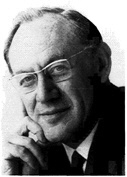Arthur M.Sackler, M.D.
1913–1987

Born in Brooklyn, New York, Arthur M.Sackler was educated in the arts, sciences, and humanities at New York University. These interests remained the focus of his life, as he became widely known as a scientist, art collector, and philanthropist, endowing institutions of learning and culture throughout the world.
He felt that his fundamental role was as a doctor, a vocation he decided upon at the age of four. After completing his internship and service as house physician at Lincoln Hospital in New York City, he became a resident in psychiatry at Creedmoor State Hospital. There, in the 1940s, he started research that resulted in more than 150 papers in neuroendocrinology, psychiatry, and experimental medicine. He considered his scientific research in the metabolic basis of schizophrenia his most significant contribution to science and served as editor of the Journal of Clinical and Experimental Psychobiology from 1950 to 1962. In 1960 he started publication of Medical Tribune, a weekly medical newspaper that reached over one million readers in 20 countries. He established the Laboratories for Therapeutic Research in 1938, a facility in New York for basic research that he directed until 1983.
As a generous benefactor to the causes of medicine and basic science, Arthur Sackler built and contributed to a wide range of scientific institutions: the Sackler School of Medicine established in 1972 at Tel Aviv University, Tel Aviv, Israel; the Sackler Institute of Graduate Biomedical Science at New York University, founded in 1980; the Arthur M.Sackler Science Center dedicated in 1985 at Clark University, Worcester, Massachusetts; and the Sackler School of Graduate Biomedical Sciences, established in 1980, and the Arthur M.Sackler Center for Health Communications, established in 1986, both at Tufts University, Boston, Massachusetts.
His pre-eminence in the art world is already legendary. According to his wife Jillian, one of his favorite relaxations was to visit museums and art galleries and pick out great pieces others had overlooked. His interest in art is reflected in his philanthropy; he endowed galleries at the Metropolitan Museum of Art and Princeton University, a museum at Harvard University, and the Arthur M.Sackler Gallery of Asian Art in Washington, DC. True to his oft-stated determination to create bridges between peoples, he offered to build a teaching museum in China, which Jillian made possible after his death, and in 1993 opened the Arthur M.Sackler Museum of Art and Archaeology at Peking University in Beijing.
In a world that often sees science and art as two separate cultures, Arthur Sackler saw them as inextricably related. In a speech given at the State University of New York at Stony Brook, Some reflections on the arts, sciences and humanities, a year before his death, he observed: “Communication is, for me, the primum movens of all culture. In the arts…I find the emotional component most moving. In science, it is the intellectual content. Both are deeply interlinked in the humanities.” The Arthur M.Sackler Colloquia at the National Academy of Sciences pay tribute to this faith in communication as the prime mover of knowledge and culture.
PNAS
Proceedings of the National Academy of Sciences of the United States of America
Contents
Papers from the Arthur M.Sackler Colloquium of the National Academy of Sciences
|
|
|
|||
|
|
Stem cells at the dawn of the 21st century |
|||
|
|
COLLOQUIUM PAPERS |
|
||
|
|
Nuclear reprogramming and stem cell creation |
|||
|
|
Maintenance of stem cell populations in plants |
|||
|
|
Stem cells of the skin epithelium |
|||
|
|
Screening for mammalian neural genes via fluorescence-activated cell sorter purification of neural precursors from Sox1-gfp knock-in mice |
|||
|
|
Normal and leukemic hematopoiesis: Are leukemias a stem cell disorder or a reacquisition of stem cell characteristics? |
|||
|
|
Little evidence of bone marrow-derived hepatocytes in the replacement of injured liver |
|||
|
|
Neuroectodermal differentiation from mouse multipotent adult progenitor cells |
|||
|
|
Ingestion of bacterially expressed double-stranded RNA inhibits gene expression in planarians |
|||
|
|
Genetic and functional differences between multipotent neural and pluripotent embryonic stem cells |
|||
|
|
Indian hedgehog and β-eaten in signaling: Role in the sebaceous lineage of normal and neoplastic mammalian epidermis |
|||
|
|
The origin and liver repopulating capacity of murine oval cells |
|||
|
|
Activation of Notch signaling pathway precedes heart regeneration in zebrafish |
|||
|
|
In vivo regeneration of murine prostate from dissociated cell populations of postnatal epithelia and urogenital sinus mesenchyme |
|||
|
|
Enhanced hematopoietic differentiation of embryonic stem cells conditionally expressing Stat5 |
|||
|
|
Nonhuman primate parthenogenetic stem cells |
|||
|
|
One strategy for cell and gene therapy: Harnessing the power of adult stem cells to repair tissues |
|||
|
|
Therapeutic cloning in the mouse |





